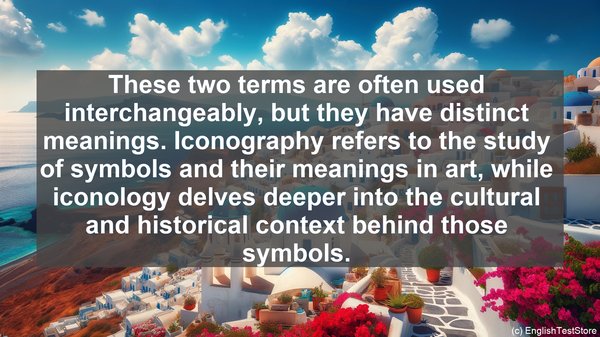Introduction: The Language of Art
Art history is a fascinating field, but it comes with its fair share of complex terminology. In this lesson, we’ll be focusing on 10 words that are often misused or misunderstood. By the end, you’ll have a better grasp of these terms, enhancing your understanding of art history.

1. Iconography vs. Iconology
These two terms are often used interchangeably, but they have distinct meanings. Iconography refers to the study of symbols and their meanings in art, while iconology delves deeper into the cultural and historical context behind those symbols.
2. Fresco vs. Mural
Both frescoes and murals involve painting on walls, but they differ in technique. A fresco is created by applying pigments to wet plaster, while a mural can be any artwork on a wall, regardless of the medium used.
3. Impressionism vs. Expressionism
These two art movements emerged around the same time, but they have distinct characteristics. Impressionism focuses on capturing the fleeting effects of light and color, while expressionism is more concerned with conveying emotions and subjective experiences.

4. Realism vs. Naturalism
Realism and naturalism both aim to depict the world as it is, but they differ in their approach. Realism presents the subject objectively, while naturalism emphasizes a detailed and accurate representation of nature.
5. Baroque vs. Rococo
These two styles flourished in the 17th and 18th centuries, but they have distinct characteristics. Baroque is known for its grandeur, dramatic compositions, and strong emotions, while Rococo is characterized by its lightness, pastel colors, and ornate details.
6. Modernism vs. Postmodernism
Modernism emerged as a response to the industrial age, emphasizing innovation and a break from tradition. Postmodernism, on the other hand, questions the idea of a singular truth and often incorporates elements of past styles in a playful manner.
7. Easel vs. En Plein Air
An easel is a portable stand used to support an artist’s canvas, while en plein air refers to the act of painting outdoors, often directly in front of the subject.
8. Gouache vs. Watercolor
Both gouache and watercolor are water-based paints, but they differ in opacity. Gouache is more opaque, allowing for more layering and corrections, while watercolor is transparent, creating a luminous effect.
9. Monochromatic vs. Grisaille
Monochromatic refers to a color scheme that uses variations of a single hue, while grisaille is a painting technique that uses shades of gray to create a grayscale image, often imitating sculpture or architectural elements.
10. Chiaroscuro vs. Tenebrism
Both chiaroscuro and tenebrism involve the use of strong contrasts between light and dark, but they differ in their overall effect. Chiaroscuro creates a gradual transition, while tenebrism has more pronounced, dramatic shadows.
